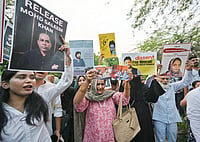Doctors treating the survivors of the triple-train accident at Balasore in Odisha are suffering from post-traumatic stress disorder (PTSD).
The PTSD is a psychological condition that often develops after a person goes through a traumatic or a terrifying incident or a phase, such as a disaster or war and conflict. It is particularly common soldiers and people from war-torn areas but people from all walks of life can develop it.
Considering mental health aspects of patients, the doctors treating survivors from the Odisha train accident have included counselling in their treatment.
Here we explain what the doctors have said, what is PTSD, and how it is treated.
Over a third of patients showing PTSD: Doctors
Doctors have said that around 40 of 105 patients at the SCB Medical College and Hospital in Cuttack are showing PTSD tendencies, reported PTI.
Dr Jashobanta Mahapatra of SCB Medical College told PTI that considering the mental health condition of the survivors, the hospital has started counselling of all patients. He said that was natural for such an accident to have severe impact on the minds of the survivors.
"Many were found to be severely stressed, fearful, panicked at times and silent. We are counselling them and talking to them along with their family members," said Mahapatra, Associate Professor, Clinical Psychology Department.
Detailing the treatment plan, Mahapatra told PTI, "Each team comprises a psychiatrist, a psychologist, a social worker and one or two members of the patient's family."
The staffers at the hospital told PTI that patients cannot sleep and wake up all of a sudden and cry out names of close ones they lost in the accident.
A 23-year-old man, whose both hands and legs have been broken in the accident, fails to sleeps during the day or at night, reported PTI.
"He fears to close his eyes as scenes of the accident flash before him," a doctor told PTI.
A second doctor told PTI that another young man, who lost his close friend, often wakes up and calls out his friend’s name. This doctor added that some patients just stare at the wall.
"These patients cry on seeing their condition while some other laugh hysterically," another doctor told PTI, adding that these symptoms can be treated over the course of time.
Mahapatra told PTI that all the patients are stable and expressed optimism that everyone will recover from the mental stress. He added that some of them could take more time than the others though.
What is post-traumatic stress disorder (PTSD)?
The post-traumatic stress disorder (PTSD) was once called shell shock or battle fatigue syndrome. It is still particularly common among soldiers or people and refugees from war-torn or conflict-prone areas.
Though common in conflict-prone areas, the PTSD can affect anyone who has been through a traumatic or terrifying episode, which may range from emotional or physical abuse to natural disaster, accidents, or loss of loved ones.
The UK National Health Service (NHS) lists the following causes of PTSD:
- serious accidents
- physical or sexual assault
- abuse, including childhood or domestic abuse
- exposure to traumatic events at work, including remote exposure
- serious health problems, such as being admitted to intensive care
- childbirth experiences, such as losing a baby
- the death of someone close to you
- war and conflict
- torture
WebMD says that PTSD symptoms can be categorised in four broad ways:
Reliving: People with PTSD repeatedly relive the traumatic incident through thoughts and memories, including from flashbacks, hallucinations, and nightmares. Conversations about the incident or its anniversary could also trigger them.
Avoiding: Avoiding people, places, thoughts, or situations associated with the trauma is also a PTSD symtom.
"This can lead to feelings of detachment and isolation from family and friends, as well as a loss of interest in activities that the person once enjoyed," notes WebMD.
Increased arousal: The people feel "jumpy" emotionally and it reflects physicall as well, such as their breathing becoming rapid and increated blood pressure and heart rate along with nausea.
WebMD says, "These include excessive emotions; problems relating to others, including feeling or showing affection; difficulty falling or staying asleep; irritability; outbursts of anger; difficulty concentrating; and being "jumpy" or easily startled. The person may also suffer physical symptoms, such as increased blood pressure and heart rate, rapid breathing, muscle tension, nausea, and diarrhea."
Negative cognitions and mood: This refers to the feelings of blame and negativeness.
"This refers to thoughts and feelings related to blame, estrangement, and memories of the traumatic event," notes WebMD.
Though once associated primarily with war and conflict, it's now understood that the PTSD can happen to anyone irrespective of background or age.
"PTSD can occur in all people, of any ethnicity, nationality or culture, and at any age. PTSD affects approximately 3.5 percent of U.S. adults every year. The lifetime prevalence of PTSD in adolescents ages 13 -18 is 8 per cent. An estimate one in 11 people will be diagnosed with PTSD in their lifetime. Women are twice as likely as men to have PTSD," notes American Psychological Association (APA).
Diagnosis and treatment of PTSD
A PTSD diagnosis involves a physical examination that's followed by mental evaluation.
The physical examination is done to determine or rule out if any physical condition is causing the symptoms.
Even though the doctors at Cuttack say the patients are exhibiting PTSD, it's said that the PTSD can be diagnosed after one month of exposure to trauma and when symptoms last for over a month. The conclusive diagnosis is done by a psychiatrists or psychologist.
WebMD says, "Psychiatrists and psychologists use specially designed interview and assessment tools to evaluate a person for the presence of PTSD or other psychiatric conditions. The doctor bases their diagnosis of PTSD on reported symptoms, including any problems with functioning caused by the symptoms. The doctor then determines if the symptoms and degree of dysfunction indicate PTSD."
It adds that PTSD is theb diagnosed if the symptoms of PTSD last for over a month.
The treatment of PTSD can involve psychotherapy, medicines, or both.
The Mayo Clinic lists three types of psychotherapies that can be used to treat PTSD:
Several types of psychotherapy, also called talk therapy, may be used to treat children and adults with PTSD. Some types of psychotherapy used in PTSD treatment include:
Cognitive therapy: It's a type of talk therapy that helps you recognise your ways of thinking, such as negative beliefs about yourself and the risk of traumatic things happening again.
Exposure therapy: It is often used along with cognitive therapy to treat PTSD. It is a kind of behavioral therapy that helps you cope with what frightens you effectively.
"This behavioral therapy helps you safely face both situations and memories that you find frightening so that you can learn to cope with them effectively. Exposure therapy can be particularly helpful for flashbacks and nightmares. One approach uses virtual reality programs that allow you to re-enter the setting in which you experienced trauma," says Mayo Clinic.
Eye movement desensitization and reprocessing (EMDR): The EMDR combines exposure therapy with a series of guided eye movements. The purpose of EDMR is to help you process traumatic memories and change how you react to them, says Mayo Clinic.
WebMD says that group or family therapies can also be considered if the PTSD affects the family as a whole or when a person could be treated upon sharing experiences and engaging with a group.
There are also certain kinds of medicines that can be used in the treatment of PTSD. These medicines include antidepressants, mood stabilizers, and antipsychotics, says WebMd, adding that certain blood pressure medicines are also used to treat nightmares, sleep issues, and in minimising the formation of traumatic memories.
Medicines and psychotherapies can often be combined to treat PTSD.


























